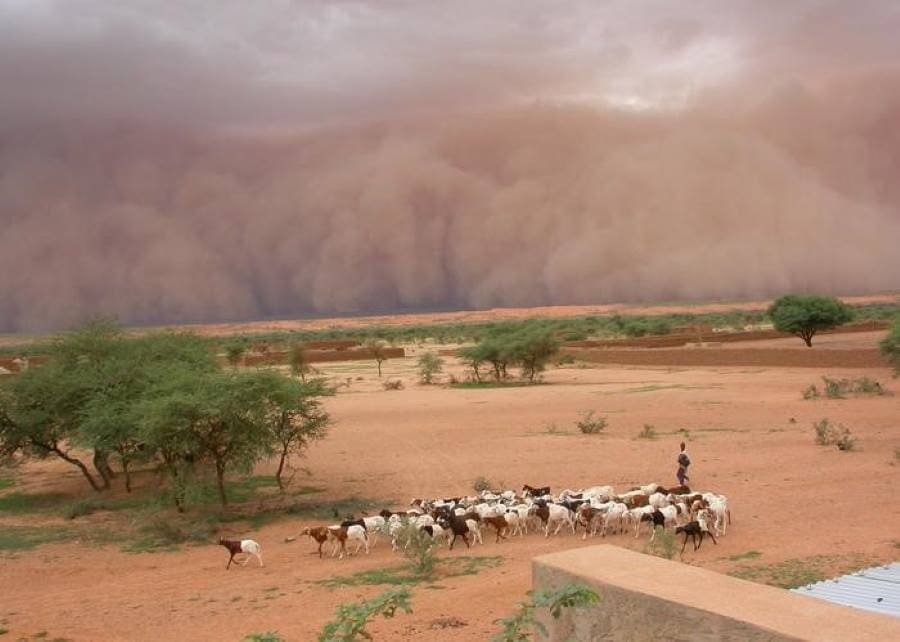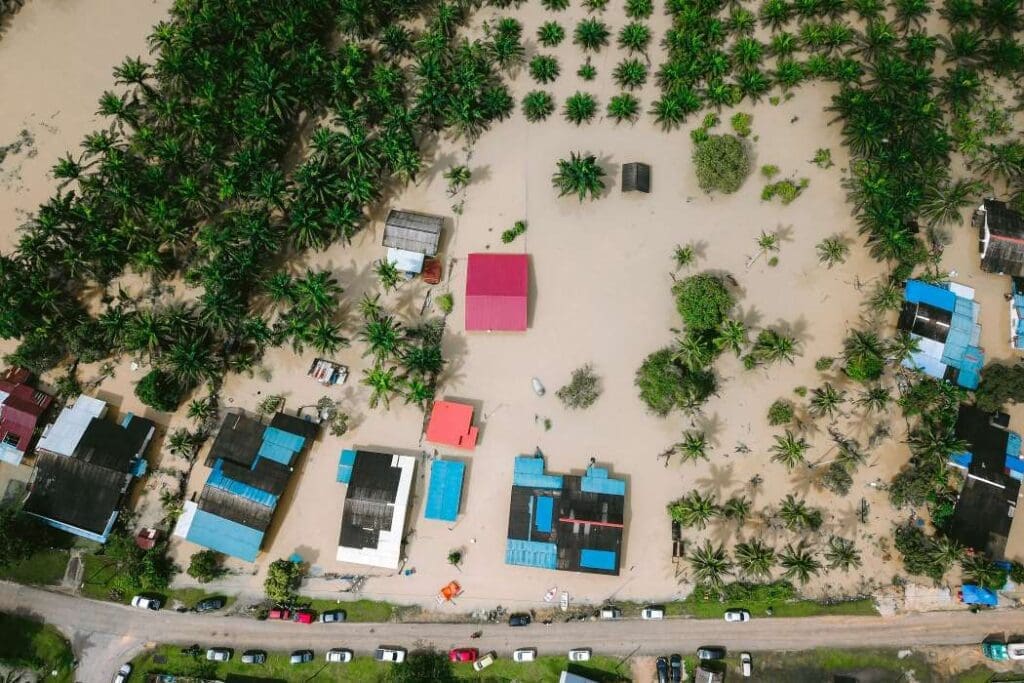Explore the latest insights from top science journals in the Muser Press daily roundup, featuring impactful research on climate change challenges.
In brief:
Soil conditions significantly increase rainfall in world’s megastorm hotspots
Storm forecasting is traditionally based on studying atmospheric conditions but ground-breaking research that also looks at land surface conditions is set to transform early warning systems in tropical regions. This will enable communities to better adapt to the destructive impacts of climate change.
The new study led by the UK Centre for Ecology & Hydrology (UKCEH) has shown that a large contrast in soil moisture levels over a range of hundreds of kilometres results in atmospheric changes that increase rainfall area and amount in several megastorm hotspots globally. This increase ranges from 10 to 30% depending on the region and size of the storm.

The research focused on mesoscale convective systems, which bring severe flash flooding and mudslides in parts of Africa, Asia, Americas and Australia that collectively have a population of nearly four billion people (see recent examples, below).
These weather systems, which can be larger in size than England and travel hundreds of kilometres, bring intense storms that kill people and livestock, as well as destroying homes, infrastructure and livelihoods.
Impacts of climate change
The study, by UKCEH, the University of Leeds (UK) and the Pacific Northwest National Laboratory (USA), has been published in Nature Geoscience.
Lead author Dr Emma Barton, a meteorologist at UKCEH, said: “Mesoscale convective systems are some of the most intense thunderstorms on the planet, and are increasing in severity due to climate change. Rising temperatures could increase the contrast between wet and dry areas of soils, further intensifying thunderstorms in already severely impacted regions.
“Understanding how soil moisture influences storm activity, and how this may change in the future, will be essential for more accurate short-term forecasting to warn communities about approaching storms, as well as making longer-term projections.”
Widespread damage
- Last year, Africa was reported to have had its worst storm season in several years. Between June and September, severe flooding in West and Central Africa, linked to heavy rainfall, killed a total of over 1,000 people, displaced more than 500,000 and destroyed over 300,000 homes.
- In Argentina in March 2025, a severe storm killed 13 people, displaced over 1,000, swept cars away and destroyed roads and bridges.
- In Bengal, India, in March 2024, a thunderstorm damaged around 800 homes, injured 300 people and killed five.
Improving warnings
The new study involved a detailed analysis of 20 years of satellite data relating to storm activity and soil moisture conditions in West Africa, southern Africa, India, South America, as well as computer modelling.
The researchers found surface conditions that influence rainfall can be observed two to five days before a storm hits, which will allow advance warning of potential flash flooding.
Early warning allows people to move themselves, their families, livestock, vehicles and possessions to upland areas, or to clear blocked drains in advance of storms to limit surface water flooding, for example.
The new study is part of ongoing UKCEH research funded by the Natural Environment Research Council (NERC). A previous study found land surface conditions often affect the direction and intensity of megastorms in the Sahel after they have formed, while a separate paper showed that deforestation increases the frequency of storms in some fast-growing African coastal cities.
Rethinking forecasting
“Meteorologists tend to focus on atmospheric conditions to predict weather patterns. But, as a growing amount of evidence shows, we should also consider what is happening on the land surface to improve forecasting,” said study co-author Dr Cornelia Klein, a meteorologist at UKCEH.
The study authors explain that greater contrast in moisture between wetter and drier areas over a large distance results in a greater contrast in air temperatures, leading to stronger shifts in wind direction and/or speed as you go higher up in the atmosphere. This turbulence helps storms grow, producing more rainfall over a larger area.
In addition to their analysis in West and southern Africa, India and South America, the researchers observed the same connection between soil moisture contrasts and wind circulations in China, Australia and the US Great Plains. So while there were insufficient storm data to carry out a full analysis, they are confident that soil moisture contrasts are also exacerbating rainfall in other regions affected by mesoscale convective systems.
Developing accurate tools
The next step for the researchers is to explore what factors contribute to these regional variations. They are also using the latest, advanced climate models, which better incorporate storms, to improve understanding of the processes that make rainfall more intense as temperatures continue to rise under global warming.
Computer software tools being developed by UKCEH are enabling meteorological agencies to generate more reliable short-term forecasting (up to six hours ahead of storms) and therefore warnings to communities about approaching storms. These include an online ‘nowcasting’ portal based on satellite-derived data on atmospheric and soil conditions in Africa.
Journal Reference:
Barton, E.J., Klein, C., Taylor, C.M. et al., ‘Soil moisture gradients strengthen mesoscale convective systems by increasing wind shear’, Nature Geoscience 18, 330–336 (2025). DOI: 10.1038/s41561-025-01666-8
Article Source:
Press Release/Material by UK Centre for Ecology & Hydrology (UKCEH)
Decarbonization improves energy security for most countries, Stanford study finds
A pivot from fossil fuels to clean energy technologies by 2060 would improve energy security and reduce trade risks for most nations, according to an April 9 study published in Nature Climate Change.
Lithium, nickel, cobalt, copper, and rare earth minerals are among the prized materials for countries and corporations racing to secure supplies for energy systems that do not add greenhouse gases to our atmosphere. Unlike fossil fuels, natural reserves of these materials are most concentrated in the Global South, shuffling the geopolitics of energy and global trade.
“Most people are focused on the new stuff that could be a problem, and not really considering the security benefits of moving away from fossil fuels,” said Steve Davis, the study’s senior author and a professor of Earth system science in the Stanford Doerr School of Sustainability. “For most countries in a net-zero emissions system in the future, trading off the reduced dependence on imported fossil fuels and increased dependence on these new materials is actually a win for energy security.”

Even for the United States, which has some of the world’s largest fossil fuel reserves but only a sliver of critical mineral deposits, decarbonization could boost energy security, especially if the country cultivates new trade partners, the researchers found.
Since 2020, the U.S. has exported more crude oil and petroleum products than it has imported – but it still imports millions of barrels daily, mostly from Canada, Mexico, Saudi Arabia, Iraq, and Colombia. “Generating electricity with solar and wind will require more imports than using abundant gas and coal resources in the U.S., but reduced dependence on foreign oil will be a big advantage as transportation is electrified,” Davis said.
Oil-rich nations including Russia and Saudi Arabia are among the minority of countries that would see energy security decline in net-zero scenarios even with expanded trade networks.
Systematic analysis and a new trade risk index
To reach their conclusions, the scientists systematically analyzed the range of each country’s potential new vulnerabilities under decarbonization relative to those associated with continued reliance on fossil fuels.
As a first step, lead author Jing Cheng, a postdoctoral scholar in Davis’s Sustainable Solutions Lab at Stanford, built a database of countries with reserves of oil, gas, coal, uranium, biofuels, and any of 16 materials that are critical for clean energy technologies, along with the trade flows of these resources between countries.
The researchers calculated how much of these resources would be required to meet energy demand in each of 236 countries in 1,092 different scenarios for reaching net-zero carbon emissions globally by 2060. Modeled by the Intergovernmental Panel on Climate Change, or IPCC, the scenarios span a broad range of possible changes to the energy mix across the globe and within individual countries. Some are more dependent on nuclear energy, for example, while others incorporate more solar or wind power.
For the thousands of combinations of trade relationships and resource needs, the team estimated the level of risk in each country’s transportation and electricity sectors, and overall energy system. They quantified these risks using a new “trade risk index” based on the availability of domestic reserves, the share of demand for a given fuel or material met by imports, the economic value of the imports, and a measure of market concentration widely used to quantify energy security.
Countries benefit from deeper cuts to fossil fuel reliance
The researchers found that if all countries maintain their current networks, trade-related risks to energy security would decline on average by 19% in net-zero scenarios. If countries expand their networks and trade with all resource owners, then trade risks on average would fall by half.
Reducing the need for imported virgin materials – whether by making technologies last longer, ramping up recycling, or developing less material-intensive designs – is another way for mineral-poor countries to minimize trade risks while eliminating fossil fuels. According to the study, trade risks fall on average by 17% – and by more than 50% for the U.S. – with a quadrupling of today’s meager recycling rates for critical minerals such as lithium, nickel, and indium.
The authors found a U.S. energy mix made up of approximately 70-75% renewables like solar, wind, and biomass; 15-20% fossil fuels; and 10% nuclear would minimize the country’s trade risks across all the modeled scenarios for reaching net-zero by 2060, although other mixes could offer advantages such as lower costs or less air pollution. Today, the U.S. relies on fossil fuels for about 83% of its energy needs, with nuclear energy and renewables providing roughly equal shares of the remainder.
Compared to solar power, wind stands to deliver greater energy security benefits for the U.S. – at least, with the trade relationships that existed at the time of the study. The materials needed to build turbines in recent years have come from a relatively large number of trade partners, Cheng explained. “However, advancing solar photovoltaic manufacturing technologies with more widely available, lower-grade silicon sources, or expanding trade networks with countries rich in silicon and manganese reserves, could further significantly bolster the nation’s energy security,” she said.
The key, as ever, is to avoid putting all the eggs in one basket. “If you’re importing a large fraction of what you need, that’s a vulnerability. If it’s all from a single other party, there’s a lot of risk that some natural disaster or geopolitical conflict could disrupt that supply,” Davis said. “You want to diversify imports among as many sources as you can.”
The security benefits of diversification have limits, however. The study results indicate that keeping fossil fuels in the mix generally drags down nations’ energy security. “It is ultimately encouraging that most countries’ trade risks decrease in net-zero scenarios,” the authors conclude, “and that the greatest improvements often occur in the countries which most drastically reduce their reliance on fossil fuels.”
Journal Reference:
Cheng, J., Tong, D., Zhao, H. et al., ‘Trade risks to energy security in net-zero emissions energy scenarios’, Nature Climate Change (2025). DOI: 10.1038/s41558-025-02305-1
Article Source:
Press Release/Material by Josie Garthwaite | Stanford University
How is climate change affecting seasonal allergies?
A review published in The Laryngoscope indicates that climate change’s effects on pollen seasons and concentrations are contributing to increasing rates of allergic rhinitis, or hay fever.
When investigators assessed research published between 2000 and 2023, they identified 30 studies that reported on the current epidemiological state of allergic rhinitis, described factors related to climate change, and observed how global warming is affecting pollen seasons and allergy symptoms.
Sixteen studies reported longer pollen seasons and/or higher pollen concentrations related to climate change. As an example, total pollen emissions in the U.S. are projected to increase by 16–40% by the end of the century and pollen season length to increase by 19 days. Four studies reported an increase in allergic rhinitis–related health care usage, particularly among low-income residents. Two studies reported that health care professionals want more education on climate change.
“Physicians are uniquely positioned to witness the impact of allergic rhinitis on patient outcomes and can adapt their practice as climate change intensifies,” said corresponding author Alisha R. Pershad, BS, a third-year medical student at the George Washington University School of Medicine and Health Sciences. “As trusted voices in the community, they should leverage their frontline experience to advocate for meaningful change in addressing the climate crisis.”
Journal Reference:
Pershad, A.R., Krishnan, R., Lee, E., Gardiner, L., Hughes, E. and Tummala, N., ‘How Climate Change Is Impacting Allergic Rhinitis: A Scoping Review’, The Laryngoscope (2025). DOI: 10.1002/lary.32124
Article Source:
Press Release/Material by Wiley
Europe’s population is adapting better to cold than to heat
A study led by the Barcelona Institute for Global Health (ISGlobal), a centre supported by the “la Caixa” Foundation, has shown that Europe has adapted better to low temperatures than to high temperatures over the last two decades.
The research, carried out in collaboration with the Barcelona Supercomputing Centre (BSC) and published in The Lancet Planetary Health, shows that there has been a significant decrease in cold-related mortality risk in recent years compared to the first decade of the 2000s. There has also been a reduction in the risk of heat-related deaths over this period, although to a lesser extent.
By analysing temperature and mortality records from over 800 regions in 35 European countries for the period 2003-2020, the researchers found that the relative risk of death in the lowest temperatures fell by 2% per year. On the other hand, the relative risk of death in the highest temperatures also decreased, but at a lower average rate of 1% per year.

New approach to account for regional differences
Traditionally, studies of this type have relied on fixed temperature thresholds to calculate risks, without taking into account that the vulnerability to identical temperatures is not the same in all parts of Europe. To overcome this limitation, the team developed a new concept: Extreme-Risk Temperature (ERT). By cross-referencing regional temperature and mortality data, this new approach made it possible to calculate the temperature at which the risk of death exceeds a certain threshold for each geographical area. The researchers also took into account variations in mortality to reflect adaptations to temperature over time.
Using this methodology, the team observed that in the period 2003-2020 Europe experienced 2,07 less dangerously cold days (cold-ERT days) each year. On the contrary, the dangerously hot days (heat-ERT days) increased by 0,28 days per year.
Interestingly, not all parts of Europe were affected the same way. For example, Southeastern European regions, despite its warmer conditions, had more dangerously heat and cold days that caused a higher risk of associated mortality.
“We have become better at coping with cold temperatures over time – a process known in science as ‘adaptation’. For hot weather, people are also becoming resilient, though this improvement is less than the adaptation to cold,” says Zhao-Yue Chen, ISGlobal researcher and first author of the study.
“The vulnerability to extreme temperatures varies widely across different locations, with regions in Southern Europe being more sensitive to temperature changes than those in Northern Europe. This disparity is partially due to socioeconomic factors, including inadequate housing insulations, lower public health expenditure and limited access to social support or assistance for vulnerable populations,” Zhao-Yue Chen adds.
“Our results show that, while Europe has done remarkable progress in adapting to cold, the strategies to cope with heat-related mortality have been less effective. A 2024 survey revealed that only 20 out of 38 European countries have implemented temperature surveillance systems, and 17 countries still do not have heat-health action plans (HHAPs). Our study highlights the need for more progress in current heat adaptation measures and heat-health action plans,” says Joan Ballester Claramunt, ISGlobal researcher and senior author of the study.
“At the same time the observed spatial disparities underscore the need for region-specific strategies to protect vulnerable populations,” he adds.
Combined effects of temperature and air pollution
The team also looked at how often Extreme-Risk Temperatures happened on days with pollution levels above the World Health Organization (WHO) recommended limits. The co-occurrence of these two events, known as ‘compound days’, happened on 60% of heat-ERT days and 65% of cold-ERT days. Over time, these combination days have been decreasing except for the combination of dangerously hot days and high levels of ozone (O3) pollution, which increased at a rate of 0.26 days per year.
Ozone is a secondary pollutant formed in the atmosphere as a result of the interaction between other gases and solar radiation. “As global warming intensifies, combined heat and ozone episodes are becoming an inevitable and pressing concern for Europe. We need to consider compound days and develop specific strategies to tackle secondary pollutants such as ozone, because the health impacts of extreme temperatures and air pollution are not completely independent. There is an interaction between them that can amplify adverse health effects,” says Zhao-Yue Chen.
***
The study has been carried out in the context of the EARLY-ADAPT project, funded by the European Research Council, and aimed at studying how populations are adapting to the public health challenges triggered by climate change.
Journal Reference:
Zhao-Yue Chen, Hicham Achebak, Hervé Petetin, Raúl Fernando Méndez Turrubiates, Yuming Guo, Carlos Pérez García-Pando and Joan Ballester, ‘Trends in Population Exposure to Compound Extreme-risk Temperature and Air Pollution across 35 European countries: a modeling study’, The Lancet Planetary Health (2025). DOI: 10.1016/S2542-5196(25)00048-8
Article Source:
Press Release/Material by Barcelona Institute for Global Health (ISGlobal)
Featured image credit: Gerd Altmann | Pixabay




